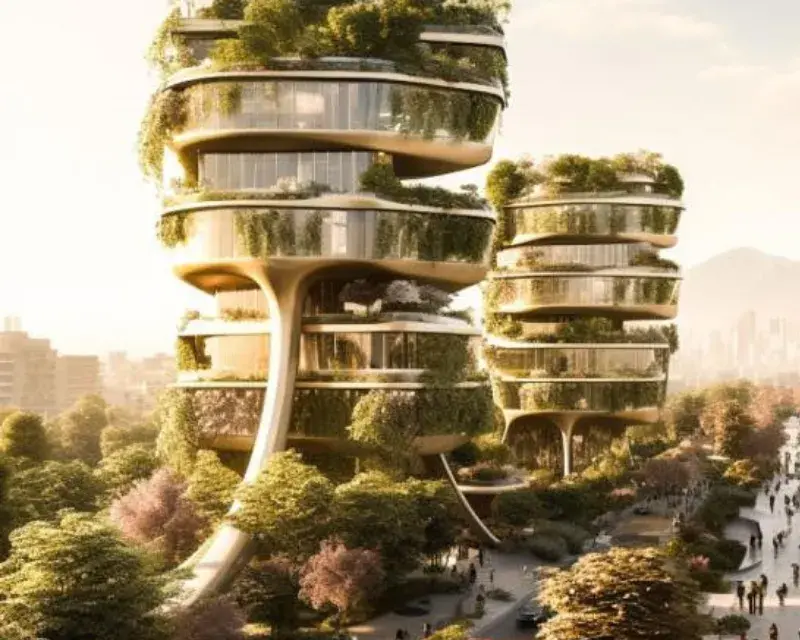In the concrete jungles of urban landscapes, a growing trend in architecture seeks to reconnect people with nature through biophilic design. This approach integrates natural elements and forms into built environments, offering numerous benefits for human health, well-being, and urban sustainability. This blog explores the concept of biophilic design in urban settings and discusses its profound impact on enhancing human health, reducing stress, and improving overall well-being.
Understanding Biophilic Design
Biophilic design stems from biophilia, a concept coined by biologist Edward O. Wilson, which suggests that humans have an innate connection with nature. Biophilic design principles aim to satisfy this innate need by incorporating natural elements, materials, and forms into architecture. In urban contexts, where green spaces are often limited, biophilic design offers a way to integrate nature into the built environment, fostering a healthier and more sustainable urban lifestyle.
Benefits of Biophilic Design in Urban Architecture
1. Enhanced Human Health: Access to natural light, views of greenery, and natural materials in urban buildings have been shown to enhance physical health by improving air quality, reducing stress levels, and boosting immune function. Biophilic elements contribute to a sense of well-being and productivity among urban dwellers.
2. Stress Reduction: Exposure to natural elements such as plants, water features, and natural materials has a calming effect on the mind and body. Biophilic design helps mitigate the negative effects of urban stressors like noise, pollution, and congestion, promoting mental clarity and relaxation.
3. Improved Cognitive Function: Studies indicate that environments designed with biophilic principles enhance cognitive function, creativity, and concentration. Incorporating natural elements in urban architecture can support learning environments, workplace productivity, and overall cognitive performance.
4. Connection to Nature: Biophilic design fosters a sense of connection to the natural world, even within urban environments. Green roofs, vertical gardens, and indoor plants bring nature closer to residents, encouraging a deeper appreciation for ecological sustainability and biodiversity conservation.
Biophilic Design Strategies
Implementing biophilic design in urban architecture involves various strategies to maximize the benefits of natural elements:
– Natural Light: Designing buildings with ample windows, skylights, and light wells to optimize daylight penetration and reduce reliance on artificial lighting.
– Green Spaces: Introducing green roofs, rooftop gardens, vertical gardens, and urban parks to provide residents with access to greenery and outdoor spaces.
– Natural Materials: Incorporating sustainable materials such as wood, stone, and bamboo into building facades, interiors, and furnishings to create a tactile connection with nature.
– Water Features: Integrating water elements like fountains, ponds, and waterfalls to enhance sensory experiences and promote relaxation.
– Views of Nature: Designing layouts that offer panoramic views of natural landscapes, urban green spaces, or indoor gardens to provide visual relief and connection to nature.
Case Studies and Examples
Cities around the world have embraced biophilic design principles to enhance urban livability and sustainability:
– Singapore: Gardens by the Bay features iconic Supertree structures and biodomes that integrate sustainable technologies with lush greenery, creating a biodiverse urban oasis.
– New York City: The High Line, a linear park built on a historic freight rail line, incorporates native plants, seating areas, and art installations to rejuvenate urban space and promote community interaction.
– Copenhagen: The CopenHill power plant combines energy production with recreational amenities, including a rooftop park and ski slope, demonstrating innovative approaches to urban sustainability and biophilic design.
Conclusion
Biophilic design represents a transformative approach to urban architecture, promoting human well-being, environmental sustainability, and community resilience. By integrating natural elements into urban landscapes, architects and city planners can create healthier, more vibrant cities where residents thrive amidst the hustle and bustle of urban life. Embracing biophilic design principles is not just about aesthetics; it’s about fostering a deeper connection to nature and improving quality of life in our increasingly urbanized world.






